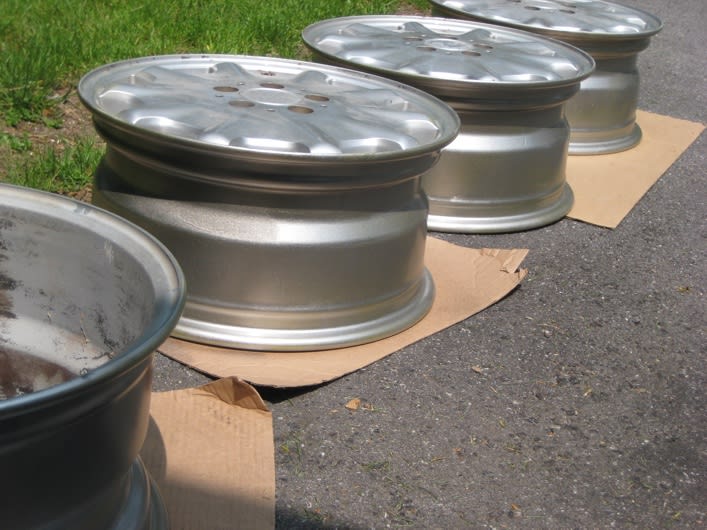The alloy wheels on our '98 Mercedes had rims leaks. Cause was corrosion in a few spots in bead area. Originally rims were coated with some sort of paint that sanded easily but was well adhered. My first effort was to sand out the corrosion, roughen the surface and apply a 1-part polyurethane moisture cure coating. This worked to some extent, but adhesion was not uniform.
I decided to strip the rims from outer edge down through the bead area to the inner rim. (about 2" wide area). I tried various methods of stripping, but in the end rotary wire brush was only thing that worked. But it left a rough surface that I still need to sand smooth.
So now I should have bare aluminum with hopefully a relatively smooth matt surface finish.
Environment:
- outer edge of the rim beyond the tire is exposed and could see salt and water.
- surface that tire rubber bead seats on may have crevices and subsequent corrosion (as occurred on original rims)
- surface inside tire bead could see moisture that condenses from air.
- the bead surface needs to be hard enough to not be damaged by tire bead pressure or movement.
Finally my questions! How do I best finish the job?
- Leave rims bare and allow them to oxidize?
- apply a phosphate primer/coating and leave it at that? (e.g. - apply phosphate primer and apply thin finish coating?
(chromate primers appear to have been outlawed)
I decided to strip the rims from outer edge down through the bead area to the inner rim. (about 2" wide area). I tried various methods of stripping, but in the end rotary wire brush was only thing that worked. But it left a rough surface that I still need to sand smooth.
So now I should have bare aluminum with hopefully a relatively smooth matt surface finish.
Environment:
- outer edge of the rim beyond the tire is exposed and could see salt and water.
- surface that tire rubber bead seats on may have crevices and subsequent corrosion (as occurred on original rims)
- surface inside tire bead could see moisture that condenses from air.
- the bead surface needs to be hard enough to not be damaged by tire bead pressure or movement.
Finally my questions! How do I best finish the job?
- Leave rims bare and allow them to oxidize?
- apply a phosphate primer/coating and leave it at that? (e.g. - apply phosphate primer and apply thin finish coating?
(chromate primers appear to have been outlawed)


